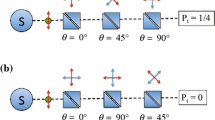Abstract
An informal theory is set forth of relations between abstract entities, includingcolors, physical quantities, times, andplaces in space, and the concrete things thathave them, or areat orin them, based on the assumption that there are close analogies between these relations and relations between abstractsets and the concrete things that aremembers of them. It is suggested that even standard scientific usage of these abstractions presupposes principles that are analogous to postulates of abstraction, identity, and other fundamental principles of set theory. Also discussed is the significance of important disanalogies between sets and physical abstractions, including especiallymodal andtemporal aspects of physical abstractions, which is related to the problem of the characterizingconstancy, of colors, physical attributes, and locations in space.
Similar content being viewed by others
References
Adams, E. W.: 1966, ‘On the Nature and Purpose of Measurement’,Synthese 16, 125–169.
Adams, E. W.: 1974, ‘On the Naive Conception of the Topology of the Surface of a Body’, in P. Suppes (ed.),Space, Time and Geometry, D. Reidel, Dordrecht, pp. 402–424.
Adams, E. W.: 1984, ‘On the Superficial’,Pacific Philosophical Quarterly 65, 386–407.
Adams, E. W.: 1986, ‘On the Dimensionality of Surfaces, Solids, and Spaces’,Erkenntnis 24, 137–201.
Aristotle: 1991,The Basic Works of Aristotle, edited by R. McKeon, Random House, New York.
Chihara, C. S.: 1984, ‘A Simple Theory of Types Without Platonic Domains’,Journal of Philosophical Logic 13, 249–283.
Chihara, C. S.: 1990,Constructibility and Mathematical Existence, Oxford University Press.
Claggett, M.: 1968,Nicole Oresme and the Geometry of Qualities and Motions, University of Wisconsin Press, Madison, Wisconsin.
Field, H.: 1980,Science Without Numbers, Princeton University Press, Princeton, New Jersey.
Frege, G.: 1884,Foundations of Arithmetic, translation by J. L. Austin, Basil Blackwell, Oxford.
Galileo: 1638,Dialogues Concerning Two New Sciences, translation by H. Crew and A. de Salvio, Dover Publications, New York.
Heath, T.: 1956,The Thirteen Books of Euclid's Elements, Dover Publications, New York.
Helmholtz, H. v.: 1887, ‘Numbering and Measuring from an Epistemological Viewpoint’, translation by M. F. Lowe, in R. S. Cohen and Y. Elkana,Hermann von Helmholtz. Epistemological Writings, D. Reidel, Dordrecht, pp. 72–114.
Hilbert, D.: 1902,Foundations of Geometry, translation by E. J. Townsend, Open Court, La Salle, Illinois.
Kant, I.: 1787,Critique of Pure Reason, translation by Norman Kemp Smith, St Martin's Press, New York.
Kelley, J. L.: 1955,General Topology, Springer-Verlag, New York.
Krantz, D., Luce, R. D., Suppes, P. and Tversky, A.: 1970,Foundations of Measurement, Vol. I, Academic Press, New York.
Maxwell, J. C.: 1877,Matter and Motion, Dover Publications, New York.
McKinsey, J. J. C., Sugar, A. C. and Suppes, P.: 1953, ‘Axiomatic Foundations of Classical Particle Mechanics’,Journal of Rational Mechanics and Analysis Vol.2 pp. 253–272.
Moody, E. and Claggett, M.: 1952,The Medieval Science of Weights, University of Wisconsin Press, Madison, Wisconsin.
Newton, Sir Isaac: 1725,Mathematical Principles of Natural Philosophy, Motte translation revised by F. Cajori, University of California Press, Berkeley, California.
Quine, W. v. O.: 1960,Word and Object, MIT Press, Cambridge, Massachusetts.
Russell, B.: 1905, ‘On Denoting’,Mind XIV, 479–493.
Sneed, J.: 1971,The Logical Structure of Mathematical Physics, Humanities Press, New York.
van Fraassen, B.: 1980The Scientific Image, Oxford University Press, Oxford.
Weyl, H.: 1949,Philosophy of Mathematics and Natural Science, Princeton University Press, Princeton, New Jersey.
Whitehead, A. N.: 1919,The Principles of Natural Knowledge, Cambridge University Press.
Author information
Authors and Affiliations
Rights and permissions
About this article
Cite this article
Adams, E.W. Classical physical abstraction. Erkenntnis 38, 145–167 (1993). https://doi.org/10.1007/BF01128977
Received:
Issue Date:
DOI: https://doi.org/10.1007/BF01128977



